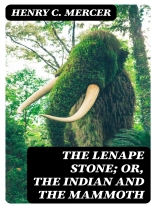In ‘The Lenape Stone; or, The Indian and the Mammoth, ‘ Henry C. Mercer weaves a compelling narrative that interlaces Native American history with paleontological inquiry. The book examines the discovery of a stone bearing an enigmatic inscription attributed to the Lenape tribe, and it explores the implications of such finds as they pertain to our understanding of early human life in North America. Mercer’s literary style is characterized by meticulous research and vivid descriptions, illuminating the cultural significance of both the Indigenous peoples and the prehistoric megafauna they coexisted with. This work sits within a rich context of early 20th-century American archaeology, engaging with contemporaneous debates regarding anthropology and indigenous rights while bridging the gap between scientific exploration and cultural heritage. Henry C. Mercer (1856-1930) was a prominent American archaeologist, historian, and the founder of the Mercer Museum in Doylestown, Pennsylvania. His lifelong fascination with Native American culture and prehistoric life propelled him to pioneer explorations in archaeology. Mercer’s background as a thinker at the intersection of science and humanities informs his writing, as he sought to recognize and preserve the narratives of marginalized communities alongside their historical significance. This book is highly recommended for readers fascinated by anthropology, archaeology, or Native American history. Mercer’s elegant prose and rigorous scholarship make ‘The Lenape Stone’ not just an informative text, but also an engaging meditation on the intricate tapestry of North America’s past, urging readers to reconsider the legacies of its earliest inhabitants.
About the author
Henry Chapman Mercer (1856–1930) was an American archeologist, artifact collector, tile-maker, and designer during the early 20th century. Mercer’s work reflected a distinct style of scholarship prevalent during his time, combining folklore, historical speculation, and early anthropological insights. Born in Doylestown, Pennsylvania, Mercer graduated from Harvard University in 1879 with a degree in law before swiftly transitioning his interest to archeology. He subsequently studied at the University of Pennsylvania and in Europe. His passion for the past led him to collect prehistoric tools and artifacts, documenting his findings in texts such as ‘The Lenape Stone; or, The Indian and the Mammoth’ (1885), which investigates a purported Native American artifact found in Bucks County, Pennsylvania, believed to depict a mammoth or mastodon—an interpretation that stirred academic debate. Mercer was a man of varied interests, and he was also instrumental in the Arts and Crafts movement, founding the Moravian Pottery and Tile Works. Although some of his archeological interpretations, such as those presented in ‘The Lenape Stone’, have since been met with skepticism in the light of contemporary evidence, Mercer’s endeavors in historical preservation and his influence on American material culture studies remain pivotal. His works provide a snapshot of the intellectual curiosity and methodology of his era, rendering him a notable figure in the tapestry of American intellectual history.












